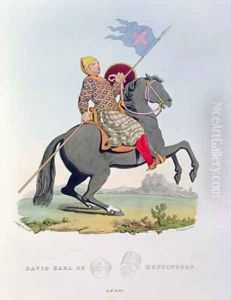Samuel Rush Meyrick Paintings
Samuel Rush Meyrick was a key figure in the study of arms and armor in the United Kingdom, born on August 16, 1783, in London. He was not a traditional artist in the sense of painting or sculpture, but his work significantly impacted the historical understanding and appreciation of medieval armor and weapons, which in turn influenced the visual arts and historical research.
Meyrick's interests led him to become one of the first serious scholars in the field of arms and armor. He pursued his passion alongside his professional career as a clergyman and, later, as a doctor of law. His groundbreaking work, 'A Critical Inquiry into Antient Armour as it Existed in Europe, Particularly in Great Britain, from the Norman Conquest to the Reign of King Charles II,' published in three volumes between 1824 and 1828, was remarkable for its detailed illustrations and historical accuracy. This publication set a new standard for the study of armor and was richly decorated with color plates that were highly regarded in the academic community.
Meyrick's meticulous approach to the classification and description of armor also led to the reorganization of the Tower of London's armory, which he undertook from 1826 to 1829. His influence extended beyond academia and helped to popularize the Gothic Revival style, which was reflected in art, architecture, and decorative arts during the Victorian era.
Beyond his scholarly work, Meyrick was also a collector, and he amassed one of the most significant private collections of arms and armor of his time. His collection was housed at his residence, Goodrich Court in Herefordshire, where he had a purpose-built armory. After his death on April 2, 1848, his collection was eventually dispersed, with many pieces finding their way into public museums, including the British Museum and the Victoria and Albert Museum, where they continue to contribute to the study and appreciation of medieval martial artifacts.
